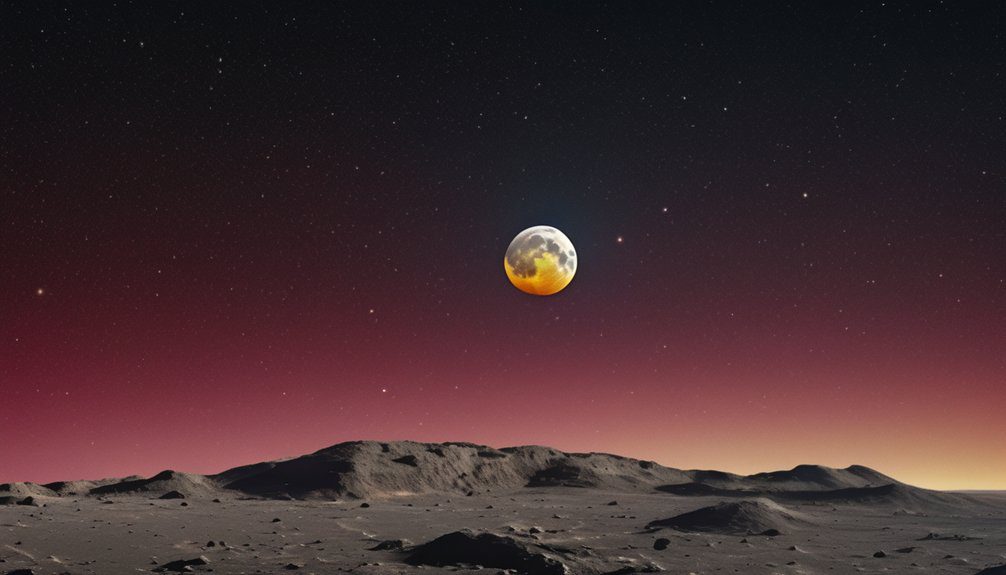You see the Moon change from red to yellow because sunlight passing through Earth’s atmosphere gets scattered by particles like dust and water vapor. When the Moon is near the horizon, its light travels through more atmosphere, scattering blue wavelengths and letting reds dominate. As the Moon rises, less atmosphere scatters light, revealing yellows and whites. These color shifts also depend on air quality and humidity. Exploring these factors reveals how natural phenomena influence lunar colors.
The Science Behind Moon Colors
Although the Moon appears to change colors at times, these variations result from specific scientific factors rather than any inherent change in the lunar surface itself.
You should understand that the Moon’s color depends primarily on how sunlight interacts with it and your vantage point on Earth. The Moon reflects sunlight, which is white light made up of many colors.
Changes in the Moon’s perceived color occur because different wavelengths of light scatter or filter differently. This process, influenced by factors like the angle of sunlight, affects the colors you see without altering the Moon’s actual surface.
Atmospheric Effects on Moonlight
The colors you observe on the Moon often result from how Earth’s atmosphere interacts with moonlight before it reaches your eyes.
As moonlight passes through layers of air, particles like dust and water vapor scatter shorter wavelengths, such as blue and green. This scattering causes the Moon to appear reddish or orange, especially when it’s near the horizon.
When the Moon is higher, the light travels through less atmosphere, reducing scattering and revealing yellower hues.
Understanding these atmospheric effects helps you grasp why the Moon’s color shifts naturally, reflecting the dynamic properties of Earth’s air surrounding you.
The Role of Moon’s Position in Color Changes
When the Moon appears near the horizon, its position causes moonlight to pass through a thicker layer of Earth’s atmosphere, which greatly influences the colors you see.
This extended path scatters shorter blue wavelengths, allowing longer red and orange wavelengths to dominate. As the Moon rises higher, the atmosphere’s thickness decreases, reducing scattering and shifting colors toward yellow and white.
Your observation of these color changes depends on the Moon’s altitude and angle relative to your location. Understanding this positional effect helps you appreciate the Moon’s shifting palette without confusion or guesswork during your nightly observations.
Natural Phenomena Influencing Moon Hues
Understanding how the Moon’s position affects its color sets the stage for exploring other natural phenomena that influence its hues.
As you observe the Moon, consider these key factors:
- Atmospheric Particles: Dust, pollution, and water droplets scatter light, altering the Moon’s color from bright white to shades of red or yellow.
- Air Quality: Cleaner air tends to produce a whiter Moon, while smoky or dusty conditions deepen red and orange tones.
- Humidity Levels: Higher humidity can amplify yellowish hues by refracting light differently.
Frequently Asked Questions
Can the Moon’s Color Affect Human Behavior or Emotions?
You won’t find solid proof that the moon’s color directly changes how you feel or act, but its shifts can inspire your mood or creativity. You’re free to let those colors influence your emotions however you want.
Do Different Cultures Interpret the Moon’s Colors Differently?
Yes, you’ll find that different cultures interpret the moon’s colors uniquely, linking them to myths, emotions, or spiritual meanings. Embrace these diverse views—they enrich your understanding and celebrate your freedom to explore beliefs.
Are There Any Myths About the Moon’s Color Changes?
Yes, many myths say the moon changes color because of battles between gods or magical creatures. You’ll find stories where its hues reflect emotions, warnings, or shifts in power, inspiring you to see freedom in its glow.
Can Artificial Lights Influence How We See the Moon’s Colors?
Yes, artificial lights can affect how you see the moon’s colors by creating glare or light pollution. To truly appreciate its natural hues, seek darker places where city lights won’t distort your view.
How Do Photographers Capture the Moon’s Changing Colors?
You capture the moon’s changing colors by adjusting your camera’s white balance, using long exposures, and shooting during different moon phases or atmospheric conditions. Experiment freely to reveal its stunning, shifting hues and unique moods.








